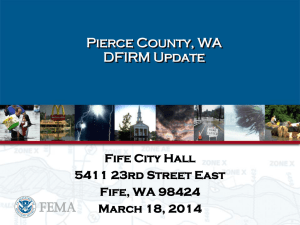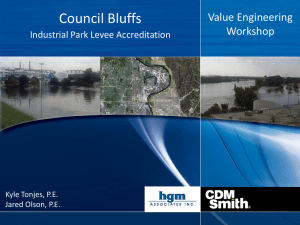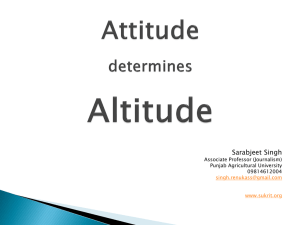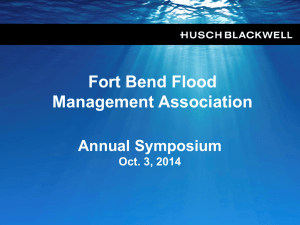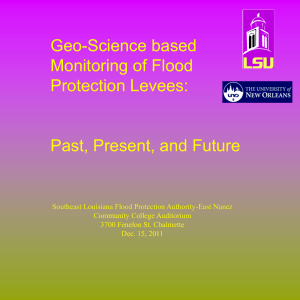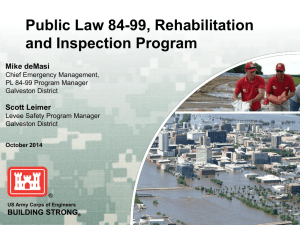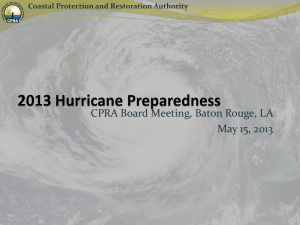BUILDING STRONG - The Association of State Floodplain Managers
advertisement
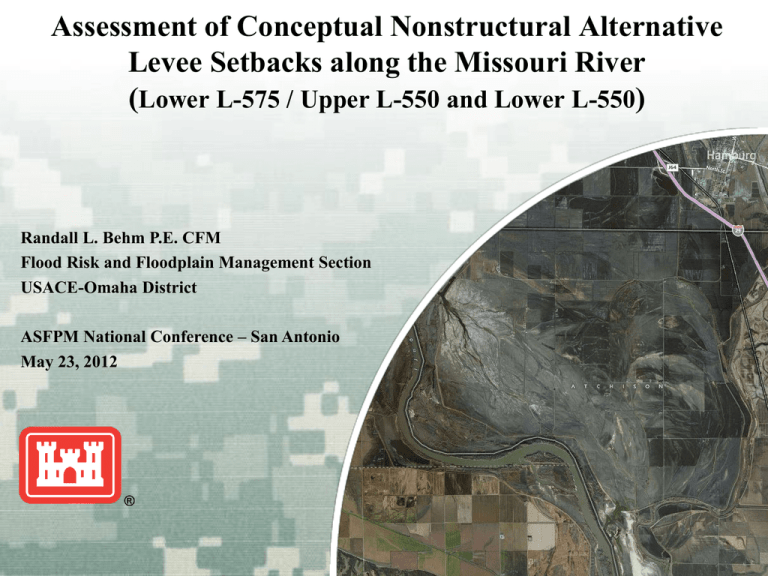
Assessment of Conceptual Nonstructural Alternative Levee Setbacks along the Missouri River (Lower L-575 / Upper L-550 and Lower L-550) Randall L. Behm P.E. CFM Flood Risk and Floodplain Management Section USACE-Omaha District ASFPM National Conference – San Antonio May 23, 2012 US Army Corps of Engineers BUILDING STRONG® Assessment Background Historic Flooding along Missouri River • long duration • large discharges • high stages • high velocities • levee breaches • levee erosion • excessive damages • recurring damage locations Gavins Point Dam Conceptual Levee Setbacks • alternative to repairs in-place • risk based assessment • flood risk considerations reduced damages sustainable reliable • enhanced environmental benefits • reconnected floodplain BUILDING STRONG® Levee System Authorization Flood Control Act of 1944 Design discharges: 250,000 cfs at Omaha 295,000 cfs at Nebraska City Freeboard: 2-feet Minimum conveyance width: 3,000 feet 1952 Council Bluffs Levee Construction BUILDING STRONG® Levee System Constrictions Federal Levee System R-520 L-536 L-550 R-548 R-562 L-575 R-573 L-594 Lake Waconda L-601 L-611-614 R-613 R-616 L-624 L-627 Omaha Levee to Levee (feet) 3,170 3,170 3,780 3,780 4,960 4,090 4,091 2,910 2,950 2,910 Levee to Bluff (feet) 34,390 3,280 2,730 3,140 Width at Bridge (feet) Significant Pinch Points 1,770 1,090 2,780 3,010 2,390 1,260 2,500 10,510 2,760 3,000 2,890 1,180 1,180 BUILDING STRONG® Levee Setback Fundamentals Levee Setbacks are a localized realignment using risk based levee design Levee Setbacks are not the complete removal of levee systems or the complete realignment of levee systems BUILDING STRONG® Levee Setback Fundamentals (potential impacts associated with existing system) High flood stages High erosive velocities Potential unsuitable foundation soils Potential high underseepage Recurring damages BUILDING STRONG® Levee Setback Fundamentals (potential benefits associated with levee setback) Reduced flood stages Reduced flood velocities Potentially more favorable foundation soils Reduced O&M RRR Reconnected historic floodplain BUILDING STRONG® Levee Setback Site Selection Process Hydraulic (conveyance/velocities/scour/deposition) Geotechnical (soils/seepage/slopes) Habitat (aerial photos/ wetlands) Critical Facilities (live risk/economics) BUILDING STRONG® Levee Setback Details for Lower L-550 Lower L-550 (Aspinwall Bend) 3.5 Miles of Levee Setback replacing 8.6 Miles of Existing Levee Stage Reductions of up to 4feet Hydraulic Constriction at RM 525 - 529 Benefits to: L-550, R-548, Cooper Nuclear BUILDING STRONG® Levee Setback Details for Upper L-550 Upper L-550 (Nishnabotna Confluence) 7.3 Miles of Levee Setback replacing 8.6 Miles of Existing Levee Stage Reductions of up to 2.7feet Hydraulic Constriction at RM 541 – 544 Historic Breach Grouping from RM 537-540 Frequent Overtopping at RM 541 Benefits to: L-550, L-575, R-562 BUILDING STRONG® Levee Setback Details for Lower L-575 Lower L-575 (Nish Confluence/Hamburg) 5.9 Miles of Levee Setback replacing 7.9Miles of Existing Levee Stage Reductions of up to 3feet Hydraulic Constriction RM 544-550 Benefits to: R-562, L-575, R-573, Nebraska City Coal Plant BUILDING STRONG® Setback results in ~50% increase in level of protection on L-550 and L-575 Setback results in ~100% increase in levee level of protection on adjacent levee systems Changes to Levee Loading Frequencies at Setback L-575 L-550 Frequency of Loading to Authorized Elevation with current alignment (year) 30 20 Frequency of Loading to Authorized Elevation with setback alignment (year) 44 28 Frequency of Loading to Levee Top with current alignment (year) 100 100 Frequency of Loading to Levee Top with setback alignment (year) 114* 120* * 100 yr used for economic analysis Changes to Levee Loading Frequencies at Adjacent Systems R-548 R-562 R-573 Frequency of Loading to Authorized Elevation with current alignment (year) 17 44 57 Frequency of Loading to Authorized Elevation with setback alignment (year) 36 114 105 Frequency of Loading to Levee Top with current alignment (year) 49 113 166 Frequency of Loading to Levee Top with setback alignment (year) 95 288 360 Reduced Probability of Flooding = Reduced Risk BUILDING STRONG® Potential Environmental Attributes L-550/L-575 11.75 square miles of new floodplain connectivity Improved inundation depth and duration frequency Positive habitat potential Potential to enhance habitat thru use of levee setback borrow areas Data indicate that on low elevation areas along the Missouri River, adult and juvenile pallid sturgeon have been found to utilize submerged floodplains for feeding (Integrated Science, February 2012) BUILDING STRONG® BCR Summary for Conceptual Levee Setback Alternatives Setback Setback Alternative with Alternative with Fix In-Place Alternative Original Level of Original Levee Protection Height (from PIRs) L-550 Level of Protection 20 years 20 years 28 years 30 years 30 years 64.6 sq miles 30 yrs upper L-575 56 yrs lower L575 64.6 sq miles $193.8M $212.6M $12.7M $14.0M $32.1M 2.52 $32.3M 2.30 L-575 Level of Protection System Protected Area 72.9 sq miles Traditional BCR computations: Total Cost $166.8M Annual Cost $10.7M Annual Benefit $33.3M BCR 3.11 BCR computations including R,R&R benefit: Annual Cost $10.7M $12.7M $14.0M Annual Benefit (including R,R&R) $33.3M $32.5M $33.2M to $34.5M Annual R,R&R CostSavings $0.0M $0.4M $1.0M to $1.8M BCR 3.11 2.55 2.37 to 2.59 Other Benefits Associated with Setback Alternatives: •Critical Facilities – $2.4M Cooper Nuclear, $4.4M Neb City Coal, Transportation •System Benefits – Increased Level of Protection on adjacent systems •Reduced O&M RR&R on adjacent systems •Less Frequency of Emergency Operations and flood-related activities •6,471 acres of potential habitat Levee setbacks would be a more expensive construction effort than repair in-place All levee setback options result in a positive benefit-cost ratio and would be worth consideration of federal investment Reduced RR&R costs increases BCR BUILDING STRONG® Constraints of taking Concepts to Reality Time and Costs Construction costs are likely higher than repairing levees Development of setback plan thru construction takes longer than repairs Authorities The PL 84-99 program relies on sponsor for real estate Levee repairs generally require little or no real estate Benefit to Cost Quantification Current methodology inhibits innovation Quantify O&M RRR, habitat, adjacent Systems, critical facilities Frequency of damages to levee system (recurring damages) Societal Concerns Unfamiliar processes “Not on my Land” initial responses BUILDING STRONG® A Flood Risk Question: If we continue to do what we have always done, why would we expect different results? Decimated Land Due to Flooding BUILDING STRONG® Questions / Comments BUILDING STRONG®
